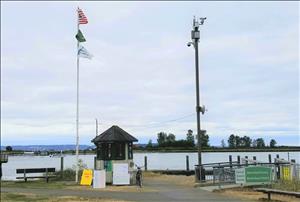On July 4, 1985, a giant fireworks shell misfires as it is launched at the conclusion of Everett's Fourth of July fireworks display on Jetty Island, located in Everett Harbor just off the city's waterfront. The 24-inch shell erupts in an enormous fountain of sparks along the ground, setting part of the island on fire. The stubborn blaze burns for three days, partly because low tides prevent firefighters from drawing sufficient water from Port Gardner Bay to fight the fire. No injuries are reported, but nearly a half-mile strip of the two-mile-long island is burned.
Thor Doesn't Soar
It was supposed to be a salute to Ivar Haglund (1905-1985), a well-known Seattle character and seafood restaurateur who had died earlier in the year. Haglund had sponsored Seattle's Fourth of July show for the preceding 20 years, so it seemed fitting for nearby Everett to dedicate the finale of its Fourth of July show to him. It would be the firing of a 24-inch, 150-pound shell, said to cost $3,000 ($7,500 in 2021 dollars). The giant firework was expected to rise more than half a mile and burst into a half-mile-wide flare resembling a chrysanthemum, visible for miles around. It even had an appropriately grand name: Thor.
A happy crowd watched the show from the Everett waterfront that evening. It went off without a hitch until it was time for Thor. The crowd waited expectantly for the launch, but something else followed: "The 24-inch shell, which was supposed to have been the largest ever launched on the West Coast, never left its mortar launcher," explained an (Everett) Herald reporter. "Instead of rising the anticipated 2,700 feet in the air before exploding, it ignited on the launching pad, immediately becoming the largest fountain ever ignited on the West Coast" ("Jetty Island Fires…").
Though nearly all the fireworks had been set off from the eastern end of the narrow island, facing the Everett shore, the pyrotechnician in charge of the show had moved the mortar for the big shell to the island's western end to get it as far away from spectators as possible. The fiery shower spewed into tinder-dry grass and set it ablaze, and the flames spread briskly in the onshore breeze. Volunteers unsuccessfully fought the fire into the wee hours of the next morning. By then, it was continuing to slowly spread among the tall grass and driftwood in the center of the island.
Don't be a Thor-Head
Firefighting efforts the next morning got off to a poor start. A fire crew being taken to the island by a police boat was stranded when the boat grounded because of the low tide. When the crew finally landed at noon, they realized the portable pumps they had brought were too small to pump water from Port Gardner Bay during low tide. When they finally got water on the fire, the resulting smoke sent a pall over the Marina Village complex and the northern part of Everett, giving residents an unpleasant reminder of the city's infamous months-long "tire fire," which had been just been put out that spring. To add insult to injury, firefighters were also forced to battle a smaller brush fire south of the main fire, which had been accidently set by revelers on the island shooting off fireworks at about the same time that the main fire erupted.
The difficulties continued the following day. That morning two of the three pumps being used to fight the fire broke down, and the remaining pump was unable to get enough water on the fire because the tide was once again out. Strong winds made the fire harder to fight and continued to send smoke over Everett's northern neighborhoods. People complained. The adverse publicity so irked the pyrotechnician that he called the Herald to state his case. He assured the paper that fireworks were safe, pointing out that the rest of the 250-piece show had gone off without a hitch. The Herald aired his views in an article titled "Don't be a Thor-head -- give the guy a break."
By the time firefighters left the island that evening they were gaining the upper hand, and they got it largely put out by the end of the next day, July 7. There were no injuries from either the blast or the fire, and though it burned a nearly half-mile strip of grass in the center of the island, damage was minor. Except for a few seagull eggs, the island's bird population was similarly unaffected, partly because their nesting areas were on the northern part of the island and not impacted by the blaze.
Six weeks after the blast, city officials announced they believed they had determined the cause of the epic fail. Apparently, neither mortar nor shell had malfunctioned. Instead, the incoming tide had weakened the sand under the 10-foot launching tube, making the launch site unstable. When the device was ignited, the sand spread the force of the ignition along the ground, which caused the shell to explode in its launcher.

